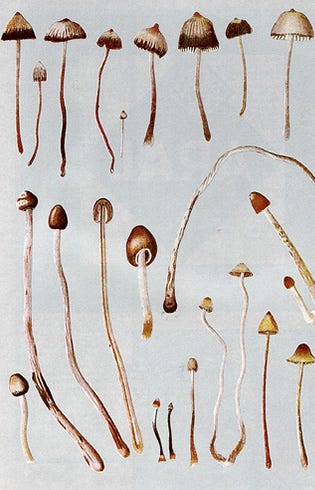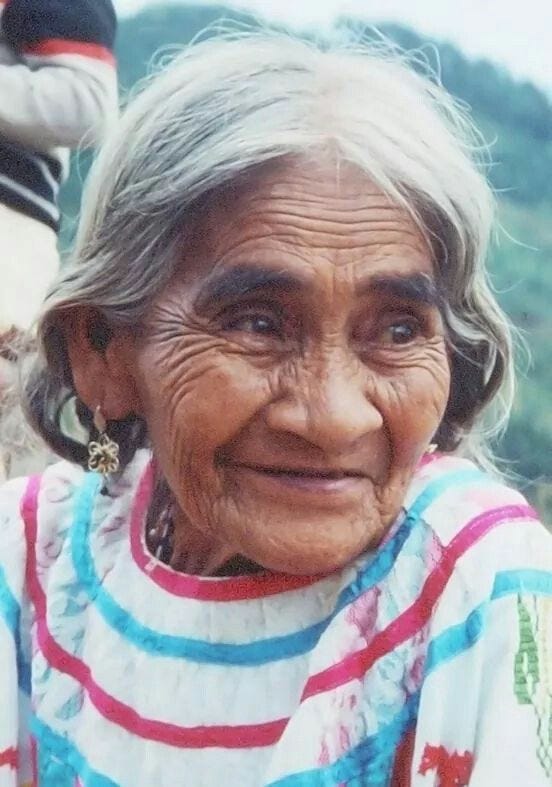All over the history of civilizations, spiritual ceremonies integrated these natural resources. Through the power of nature, indigenous people created bridges to the divine. Until now, rituals are still used to heal and connect with the Universe.
(MEDIUM) Approximately 5000 plants are traditionally used as a medicine by 52 different ethnicities in Mexico.
The Aztec civilization (~13th century), was the first to record the use of medicinal herbs.
The Huicholes for example used the hallucinogen Peyote Cactus for religious ceremonies. It granted them healing skills and the ability to communicate with their gods.
Also, in the mountainous region of the Sierra Mazateca, in the state of Oaxaca, certain mushrooms were sacred. Designated as ‘teonancatl’ in Nahuatl language, meaning “Flesh of the Gods”. Shamans used their properties as medicine to heal people. These traditions subsisted to the restrictions imposed by the Conquista in the 16th Century and adapted to the rising interest of foreigners.
María Sabina
Her full name was María Sabina Magdalena García, she was a Mazatec healer, who lived in Huautla de Jiménez, in the Sierra Mazateca. Born around 1894, she had a younger sister, and her parents were “Campesinos” (Pheasants), workers of the land. Men on her father’s side were shamans, using the mushrooms to communicate with God, according to their beliefs. After the death of her father, María Sabina grew up in the house of her maternal grandparents, both farmers.
At the age of fourteen, she was married to Serapio Martínez, a twenty-year-old young man, María Sabina’s first husband. He worked as a street vendor. Together they had 3 kids. On one of his trips to Tehuacán, he joined the Carranza forces to be part of the Mexican Revolution. He died shortly after his return from an illness.
For the next 12 years, she continued to till the land and raise chickens for the sustenance of her three children. She later married Marcial, a healer who was alcoholic and violent with her, her children, and her mother. They had 6 kids together, 5 of them died. Her husband was finally killed by the children of the lover with whom he was cheating.
She decided to sell her chickens and bought a mule that she carried with merchandise, as did her first husband. Her children were helping her, which allowed the family to subsist. One day, confronted to the serious illness of her only sister, María Sabina started to use the mushrooms to provide a cure to her sister. Her sister recovered and María Sabina’s healing abilities started to be known.

Becoming a healer
She became the famous priestess, shaman, and oral poet called “La Señora”. Her sacred ceremonies, called veladas, included the intake of psilocybin mushrooms, Mazatec chants, tobacco smoke, mezcal consumption, and ointments extracted from medicinal plants. Under the entheogenic use of the sacred mushrooms (hongos sagrados), María could heal the one in need during the velada. The shamanic trance was accompanied by beautiful poems, dances, incantations, and chants. María Sabina did not take credit for her poetry. The mushrooms — her “niños santos”, or “holy children”, as she called them — spoke through her; she was their interpreter, and she treated them with great respect. She was receiving donations or food in exchange for her healings.
An opening to the West
She was the first healer to accept foreigners in the mushrooms ceremony. In 1953, a team of 3 foreigners came to meet the shaman María Sabina in her village. Robert Gordon Wasson, a North American passionate of mycology, Robert Heim, a scientific, and Guy Stresser-Péan, their guide. Together, they launched a vast multidisciplinary survey. It is claimed that through the study, they made the hallucinogen available to science.
Wasson’s account of his experience beside María Sabina was published in an issue of LIFE magazine in June 1957. The publication “Seeking the Magic Mushroom” went viral upon its publication.
In the next decade, the village of Huautla could see a constant arrival of scientists and hippies in quest of the mystic experience. They were not only coming to listen to the chants but also to ingest the mushrooms.
María Sabina mentioned that “before Wasson, nobody took the children simply to find God. They were always taken to cure the sick.”
Troubles
The surge of popularity put Maria in trouble. The police accused her of drug dealing. The Westerners were losing control and respect under the influence of mushrooms. The community was offended by the commercialization of its rituals. María ended up being rejected from her village for years and her house was burnt down.
Supported by the fame, María Sabina began to travel to different cities and presented her practice to heterogeneous audiences. Yet, the faith and conviction of María Sabina have never faded away. María Sabina preserved the ancient Mazatec ceremonies and rituals, rooted in Pre-Columbian Mexico.
María Sabina’s chants and poems are well documented, mostly due to the reports made by her visitors. Alvaro Estrada compiled dozens of recordings he made of María’s Veladas between 1955 and 1970. Her chants were translated into Spanish and then into English and released in a book titled María Sabina, Her Life, and Chants (affiliate link for those interested).
Her words of wisdom become pieces of advice for us all:
“Cure yourself with the light of the sun and the rays of the moon. With the sound of the river and the waterfall. With the swaying of the sea and the fluttering of birds.
Heal yourself with mint, with neem and eucalyptus.
Sweeten yourself with lavender, rosemary, and chamomile.
Hug yourself with the cocoa bean and a touch of cinnamon.
Put love in tea instead of sugar, and take it looking at the stars.
Heal yourself with the kisses that the wind gives you and the hugs of the rain.
Get strong with bare feet on the ground and with everything that is born from it.
Get smarter every day by listening to your intuition, looking at the world with the eye of your forehead.
Jump, dance, sing, so that you live happier.
Heal yourself, with beautiful love, and always remember: you are the medicine.”

The Yucatan Times
Newsroom


